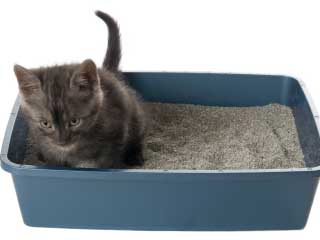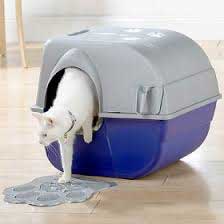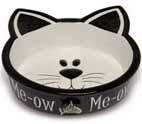Cat Litter Box Training
Cat litter box training is one of the first things to teach your new pet, and if enough time and patience is given to it from the beginning it should not pose too much of a problem to either of you. In fact one of the most common questions I am asked is "How to litter train a kitten"? I hope to answer it here.
Cats are essentially clean and private animals when it comes to their bodily waste. By providing them with a clean and discreet tray where they can bury their waste, you will help ensure that they choose the litter tray first rather than any where else.
On This Page :
- Reasons cats won't use Litter box
- Choosing the right box for your cat
- Toilet training cats to use the litter box
- Re-training to use box again
Why Won't They Use The Cat Litter Box

There could be many reasons why your cat won’t use the cat litter box:
- It’s not clean enough – always make sure that the litter is replaced after use and that the tray itself is clean.
- The type of litter or the box is disliked– watch how your cat reacts to the litter box and this will give some indication if one or the other is the problem. As I mentioned earlier, Mo hated the design of her litter box. Find out more about the different types of litter trays and litter available.
- It is too near to their food bowls – if possible make sure that these two areas are completely separate.
- It is not private enough – Try to place the tray in a corner where the cat is not looked at and can feel relaxed.
- They don’t like to share the litter tray with other cats – often the scent of other cats will deter them from using the same tray.
By making sure that you have made the cat litter box as appealing as possible to your cat, there should not be any reason why your cat toilet training efforts should not be fruitful. Of course there may be a behavioural or health issue that may be affecting your cat using the litter tray. See our pages on Cat Behavior and Cat urine for more information.
Choosing The Right Box and Litter

A plastic tray is the easiest to use especially for cleaning. Cardboard boxes might be useful in the short term until you can buy a plastic one. But cardboard will become soiled easily and begin to smell quite quickly.
Make sure that the sides of tray are high enough so that when your cat is covering their waste the litter is not kicked out of the box too easily, but remember to make one side of the box lower for easily access. This is specially important for a kitten.
There are many different types of litter on the market, from paper, wood, and silica shell. But the most common type is clay based. When choosing a litter think about how your cat will feel walking on it. For instance in the wild cats will find the softest ground to use, so anything which might feel uncomfortable to walk on could put kitty off from using the cat litter tray.
One of the main benefits of clay-based litter is its ability to clump once wet. This makes it very easy to scoop out the soiled litter and leave any clean and unused litter in the tray.
However not all clumping litters are the same so always read the information on the litter bag and take guidance to how often the litter should be entirely changed and if it is suitable for all ages of cat and kitten.
Also try not to use a scented cat litter when toilet training cats. It might make your house smell nice but your cat may find it very off putting. Most of the cat litters have odour neutralisers in them, which do not have a smell in themselves but take away any cat urine etc smells.
See our page on different types of litter and trays to find the one that will suit your cat and it's environment the best.
How To Train A kitten Or Cat To Use A Cat Litter Box
The first rule is to never punish your cat or kitten for eliminating somewhere other than their cat litter tray in the house. They just won’t make the connection between you shouting at them or rubbing their noses in the mess. It will just make them fearful of you.
If you are training a cat or kitten who has never used a cat litter tray before, then this is the process to use to teach them:
- Make sure that nothing unpleasant happens near the litter tray like giving them medicine or loud noises (washing machine). Your aim is for them to see the cat litter box as a safe place.
- Make sure you are around at times when they will want to use the litter tray. Most cats and kittens will want to eliminate shortly after waking, after eating or after exercise or play. Watch your pet at these times; they will start to sniff around looking for a place to go.
- Place the box so that they can see it and encourage them to come and investigate. Perhaps tap the box to gain their attention and then scratch the litter to show the cat.
- Praise your cat if they go into the box and if they do perform, make lost of fuss of them and give them a treat. This way they will see that by using the tray they will have a reward.
- Always use the same litter if possible and make sure that the cat litter box is always clean. Cats are creatures of habit and don’t like change. Familiar smells and textures will make sure that they always use their litter tray.
Most cats are quick learners and by repeating the process everyday they will soon learn that it is a good experience when they use the cat litter box and will use it by themselves within a few weeks if not sooner.
The Re-Training Confinement Process
in some cases cats need some time to adjust to the litter tray again after a period where they may have been upset and have urinated outside the litter tray. In which case a period of confinement with the tray will help them to become confident and restablshed with using the litter tray.
Keep your cat in a pen or small room forbetween 4 and 7 days, with their
- toys,
- water
- litter tray (feed them out of the pen/room in their usual spot then replace them back in the pen.
Then gradually after this period begin to reintroduce them to the rest of the house again.
If new pets or children are the cause, then gradual introduction is required. All of these measures are designed to help the cat come to terms with the new situation and also to become less nervous in their home environment.
It may sound an extreme measure to confine a cat for a week or so, especially if the behaviour is from a cat that has lived with you for many years. But if you look at it from your cats point of view, they have started to display and extreme behaviour , they would not do this unless they were very upset about something. As we cannot explain to them with words we have to show them gently and gradually not to be afraid
Top of this Cat Litter Box Page








